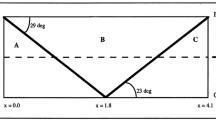Abstract
The performance of a numerical method which solves flow at all speeds, and does not use any explicit artificial viscosity or damping mechanism whatsoever, is investigated by testing a number of selected cases in compressible and incompressible flows. Contrary to existing methods, the momentum components are chosen as the dependent variables instead of the velocity components in order to provide a number of advantages. Among the motivations for this change is a flow analogy which permits incompressible methods to be used to solve compressible flows. The method is formulated within a control-volume-based finite-element approach using a collocated grid arrangement. The definition of two types of mass flux components at the control volume surfaces removes the possibility of velocity-pressure decoupling in the incompressible or Euler limits. In the absence of any dissipation mechanisms, the main concern of this work is to evaluate the performance of the method and the analogy for solving high speed compressible flows with shocks. The results and performance of the present work are compared with the exact and benchmark solutions and the results of other workers who use dissipation mechanisms to solve flow at all speeds.
Similar content being viewed by others
Author information
Authors and Affiliations
Rights and permissions
About this article
Cite this article
Darbandi, M., Schneider, G. Performance of an analogy-based all-speed procedure without any explicit damping. Computational Mechanics 26, 459–469 (2000). https://doi.org/10.1007/s004660000194
Issue Date:
DOI: https://doi.org/10.1007/s004660000194




